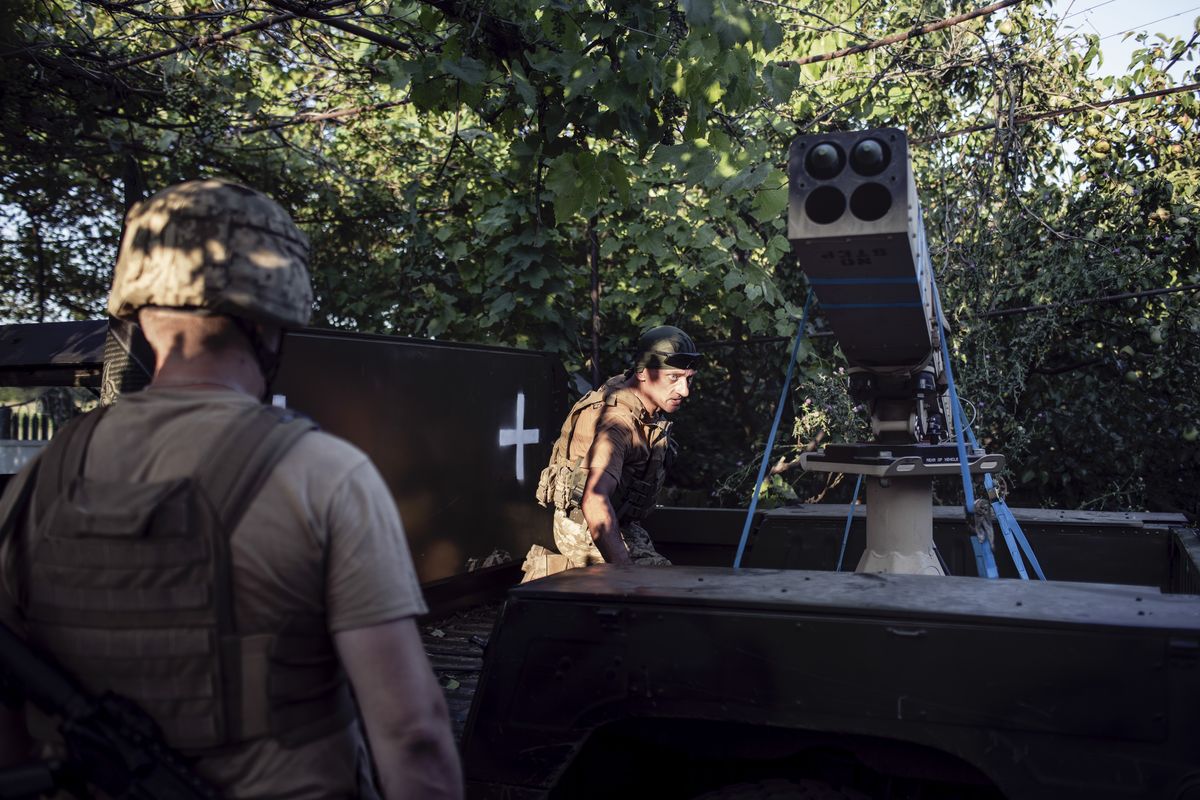Russian strikes kill 7 Sunday morning in Ukrainian region under ceaseless shelling

Russian shelling ripped into homes in the Kherson region of southern Ukraine on Sunday morning, officials said, an assault that killed at least seven people, including a family of four, in an area that had already borne a heavy toll from relentless Russian bombardment.
A couple, their 23-day-old daughter, Sofia, and their 12-year-old son, Artem, were killed when a strike hit their yard in the village of Shyroka Balka around 10 a.m., the Kherson regional military administration said. Another resident of the village also died.
Calling it “another tragic day” for the region, Oleksandr Prokudin, the head of the regional military administration, said that shelling also killed two men – including the 67-year-old local pastor – in the village of Stanislav.
“Today, the Kherson region shook with terrible news,” Produkin said in a statement, adding that nine people also had been injured in the strikes and that Monday would be a day of mourning. The regional health authorities issued an “urgent” call for blood donors.
Details about the attacks in the Kherson region Sunday could not be independently verified, and Russia’s Ministry of Defense did not immediately comment. But the region has been under nonstop shelling since November, when Russian forces retreated from the regional capital, the city of Kherson, across the Dnieper River. From their new positions on the river’s eastern bank, Moscow’s troops have launched regular and deadly attacks on the city they once occupied and the towns around it.
Prokudin said in a separate statement before the latest attacks that Russian forces had fired 365 shells at the region over the previous 24 hours, injuring three people.
The strikes come as Ukrainian forces continue to wage a counteroffensive to recapture Russian-occupied territory in the country’s south. The campaign, which began more than two months ago, has been slow and bloody.
Even as Ukrainian soldiers battle in trenches and on the field, the campaign to sever Russian supply lines continues, with Ukraine increasingly targeting places far from the front lines. In recent weeks, Moscow has repeatedly accused Ukraine of launching attack drones at sites inside Russia, including at the capital.
On Sunday, Russia’s Ministry of Defense said it had shot down four Ukrainian drones in border regions – three over the Belgorod region and one over the Kursk region. The claims could not be independently verified.
There was no immediate comment from Ukrainian officials, who typically avoid claiming responsibility for attacks on Russian soil but in recent weeks have indicated that the war’s devastation would not be limited to Ukrainian territory.
One repeated target of Ukrainian strikes far from the front lines has been the Kerch Strait Bridge, a vital Russian link to the occupied Crimean Peninsula that Ukraine has vowed to keep striking until the structure is unusable.
Despised by Ukrainians as a symbol of Russian occupation – Russian President Vladimir Putin ordered it built after illegally annexing Crimea in 2014 – the Kerch bridge has been a target since the war began. Ukraine has already hit it twice. Beyond its symbolic value, the 12-mile span is a critical strategic asset, allowing Moscow to move troops and equipment from Russia to its bases in Crimea and then onto the battlefield in southern Ukraine.
Russia’s Ministry of Defense said Saturday that it had downed a Ukrainian missile targeting the bridge and that there was no damage. Video broadcast on the Russian and Ukrainian state news media showed smoke billowing over the span, though the Russian-installed authorities in Crimea said it was just a smoke screen intended to protect the bridge. The claims could not be independently verified, and Ukrainian officials did not immediately comment.
Maria Zakharova, the spokesperson for Russia’s foreign ministry, condemned the attack and threatened retaliation against Ukraine, saying it “will not remain without a response,” the Russian state news agency Tass reported Saturday.
On Sunday, the spokesperson for the Ukrainian air force, Yuriy Ihnat, was asked about the previous day’s explosions around the bridge and said it was “not clear” what had occurred.
“We speak about these things with restraint,” he said on national television, but added “what is happening will continue to happen – unmanned aerial vehicles and strike drones productions are developing.”
Tensions in the Black Sea
Russia’s Defense Ministry said Sunday that one of its patrol ships in the Black Sea had fired warning shots at a cargo vessel that had failed to stop for inspection.
It said the cargo ship stopped after the “warning fire” and Russian servicemen boarded to carry out an inspection, then allowed the vessel to continue its journey to the Ukrainian port of Izmail on the Danube River.
The defense ministry’s claims could not be independently verified. They come amid heightened tensions in the Black Sea following Moscow’s decision last month to withdraw from a U.N.-brokered deal ensuring the safe passage of Ukrainian grain exports and warn that any vessels attempting to reach Ukraine would be treated as hostile.
Since then, Russian forces have bombarded Ukrainian ports – including Izmail – in what Ukrainian officials said were strikes specifically targeting the country’s ability to ship grain.
Ukraine retaliated last week with two strikes on Russian ships on consecutive days – demonstrating its new reach with sea drones that can hit Russian ports hundreds of miles from its coast. It also issued its own warning that six Russian Black Sea ports and the approaches to them would be considered areas of “war risk” until further notice.
This article originally appeared in The New York Times.